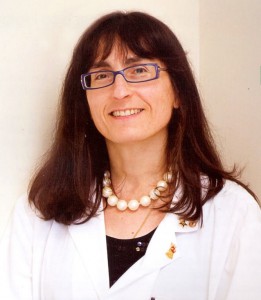For October 2015, we have selected: M. Goedert. Alzheimer’s and Parkinson’s disease: The prion concept in relation to assembled Aβ, tau, and α-synuclein. Science 2015;349(6248):1255555. Doi: 10.1126/science.12555550.
In this review of Michel Goedert, the pathophysiology of the two most frequent neurodegenerative disorders, Alzheimer’s disease (AD) and Parkinson’s disease (PD), is unified in a common process that shares the prion-like spreading of abnormal protein assemblages inside the brain.
AD and PD have been recently considered as proteinopathies, i.e. diseases in which the deposition of abnormal proteins can induce cellular and extracellular damage to death, with related networking dysfunction. The intraneuronal accumulation of neurofibrillary tau and the extracellular deposition of amyloid (Aβ plaques) are the pathological hallmark of AD, whereas intraneuronal depositions of abnormal α-synuclein (Lewy bodies and neuritis) characterise PD.
Prions are “proteinaceous infectious particles” (misfolded prion proteins) that can replicate without nucleic acid and slowly propagate from one neuron to another probably trans-synaptically. The most well-known prion disease is Creutzfeldt-Jakob disease.
AD and PD seem to share some aspects of classical prion diseases. For example, in AD some types of Aβ filaments seem to be more aggregation-prone (and thus more toxic) than others (like the different forms of the prion protein), and assembled tau slowly spreads from one region to another inside the brain. In PD, the aggregated α-synuclein assembles in Lewy bodies that would spread inside the brain following specific stages of propagation.
The main concept that is that, in both AD and PD misfolded proteins, assembled in β-sheet-rich conformation, act as pathological seeds inducing aggregation of soluble proteins. These seeded aggregations grow, divide, and generate other pathological seeds that spread and eventually generate pathological filaments. Misfolded proteins can be the product of mutations in the amyloid precursor protein (as in inherited AD), in the tau gene MAPT (as in inherited fronto-temporal dementia), or in the α-synuclein gene SNCA (as in inherited PD). In sporadic diseases, the formation of pathological proteins is probably stochastic, with distinct forms of aggregates underlying different diseases.
“AD and PD have in common specific pathological stages, in which a progressive prion-like dissemination of the respective pathologies from region to region along anatomical connectivities can be recognised,” says Prof Kelly Del Tredici MD, PhD, Department of Neurology (Clinical Neuroanatomy), University of Ulm, Germany. “It remains to be clarified for PD whether the enteric nervous system is involved before the central nervous system. This will be important for the development of potentially effective therapeutic strategies.”
“The spreading of pathological α-synuclein is likely the most important factor inducing neuronal death and dysfuction in PD”, says Prof Ronald Melki, Paris-Saclay Institute of Neuroscience, CNRS, Gif-sur-Yvette, France. “AD and PD are multifactorial diseases, since Lewy bodies can be absent in some genetic PD, other mechanisms can be responsible of dopaminergic nigro-striatal denervation. Indeed, there is increasing evidence that the protein interaction network of α-synuclein and tau and mutations within genes encoding proteins such as LRRK2 and glucocerebrosidase play an important role in disease progression. Nevertheless, these new hypotheses about PD and AD pathophysiology stimulate research towards focused treatments acting directly on the pathological seeds, thus interfering with their aggregation and fragmentation.”
The other nominees for the October’s paper of the month are:
- DiPALS Writing Committee, on behalf of the DiPALS Study Group Collaborators. Safety and efficacy of diaphragm pacing in patients with respiratory insufficiency due to amyotrophic lateral sclerosis (DiPALS): a multicenter, open label, randomized controlled trial. Lancet Neurology 2015;14:883-892.
Non-invasive ventilation plus pacing with the NeuroTx RA/4 Diaphram Pacing System was compared to non-invasive ventilation alone in 74 ALS patients with respiratory insufficiency in the UK. At the end of this 3-year study, patients with non-invasive stimulation alone survived longer and had less adverse events compared to patients with non-invasive ventilation and diaphragm pacing.
- Barzel A, Ketels G, Stark A, et al. Home-based constraint-induced movement therapy for patients with upper limb dysfunction after stroke (HOMECIMT): a cluster-randomised, controlled trial. Lancet Neurology 2015;14:893-902.
The efficacy of constraint-induced movement therapy (CIMT) during daily activities at home was studied in 86 patients with upper limb dysfunction after stroke in Germany. Compared to a randomised group of patients receiving standard group therapy, patients with home CIMT had better improvement of quality of movements, although motor function improvement was similar in both groups of patients.
- Gnann JW, Sköldenberg B, Hart J, et al., for the National Institute of Allergy and Infectiuos Disease Collaborative Antiviral Study Group. Herpes simplex encephalitis: Lack of clinical benefit of long-term valacyclovir therapy. JAMA 2015;313:1939-1949. CID 2015;61:683-691.
In this study 87 patients with confirmed herpes simplex encephalitis (HSE), previously treated with standard IV acyclovir, were randomized to have valacyclovir (VACV) 2 g orally 3 times a day versus identical placebo tablets during a 3-month period. At 12 months, no differences were found between groups in the neuropsychological assessment using the Mattis Dementia Rating Scale.
- Li L, Yiin GS, Geraghty OC, et al., on behalf of the Oxford Vascular Study. Incidence, outcome, risk factors, and long-term prognosis of cryptogenetic transient ischaemic attack and ischaemic stroke: a population-based study. Lancet Neurology 2015;14:903-913.
In this study UK study involving 2555 patients with a first TIA or ischaemic stroke no differences were found in death or dependency at 6 months and in the 10-year risk of recurrence in 812 patients with cryptogenetic stroke (TOT) compared with non-cardioembolic stroke patients. However, patients with cryptogenic events had the fewest atherosclerotic risk factors and no excess of cardioembolic markers.






